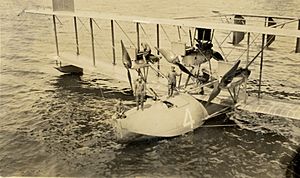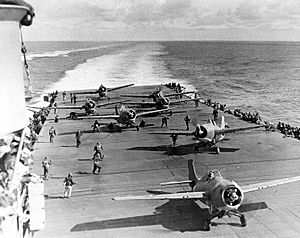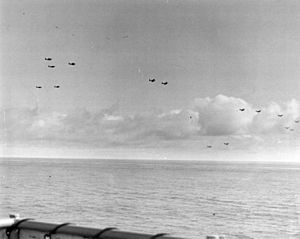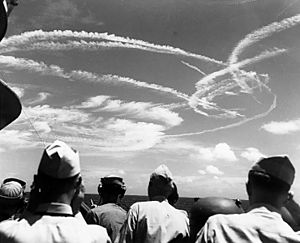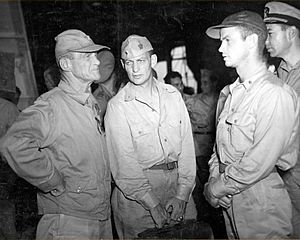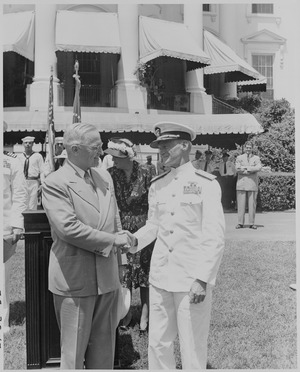Marc Mitscher facts for kids
Quick facts for kids
Marc Andrew Mitscher
|
|
|---|---|
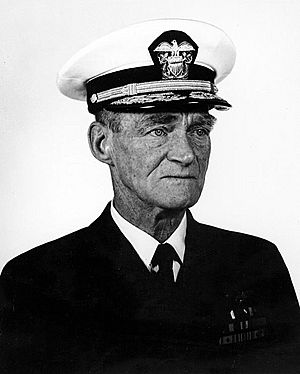
Vice Admiral Marc A. Mitscher during World War II
|
|
| Nickname(s) | "Pete" |
| Born | January 26, 1887 Hillsboro, Wisconsin |
| Died | February 3, 1947 (aged 60) Norfolk, Virginia |
| Place of burial | |
| Allegiance | |
| Service/ |
|
| Years of service | 1910–1947 |
| Rank | |
| Service number | 7591 |
| Commands held | USS Wright USS Hornet Commander Air, Solomon Islands Fast Carrier Task Force Eighth Fleet Atlantic Fleet |
| Battles/wars | |
| Awards |
|
Marc Andrew "Pete" Mitscher was a brave American admiral and a true pioneer in naval aviation. He was born on January 26, 1887, and passed away on February 3, 1947. During the second half of World War II, he led the powerful Fast Carrier Task Force in the Pacific Ocean.
Contents
Marc Mitscher was born in Hillsboro, Wisconsin, in 1887. When he was two, his family moved to Oklahoma City, where his father later became the city's second mayor. Marc went to school in Washington, D.C.. In 1904, he got a chance to attend the United States Naval Academy in Annapolis, Maryland.
At first, Marc wasn't the best student. He got a lot of demerits, which are like penalty points. He was even asked to leave the academy at one point. But his father insisted, and Marc was allowed to re-enter. This time, he worked very hard. He graduated in 1910 and became an ensign, a low-ranking officer, in the Navy.

Marc Mitscher was very interested in flying. He kept asking to join the Navy's aviation program. Finally, he was sent to the Naval Aeronautic Station in Pensacola, Florida. He trained as a pilot and earned his "wings" on June 2, 1916. This made him one of the very first naval aviators!
During World War I, Mitscher commanded a naval air station. The Navy wanted to use aircraft for scouting and helping ships aim their guns. Mitscher helped train pilots for seaplanes, which are planes that can land on water.
Between the World Wars
First Transatlantic Flight Attempt
In May 1919, Mitscher was part of a group of naval aviators who tried to fly across the Atlantic Ocean for the first time. He piloted one of three large flying boats called "Nancys." They took off from Newfoundland. But thick fog made flying very dangerous. Mitscher's plane had to land in rough seas, and a control cable broke. He and his crew had to wait on the plane's wing to be rescued. Only one of the three planes, the NC-4, successfully made it across the Atlantic.
After this, Mitscher continued to work with naval aviation. He helped develop how aircraft would be handled on the Navy's first aircraft carrier, Langley. This ship was slow, but Mitscher and others learned how to launch and recover planes from its deck. Many of their ideas are still used today!
Mitscher also helped with the new aircraft carrier Saratoga. He was the first person to land a plane on its flight deck. He learned that it was important to find and destroy enemy aircraft carriers early in a battle. In 1938, he was promoted to captain.
World War II Hero
Leading the Hornet
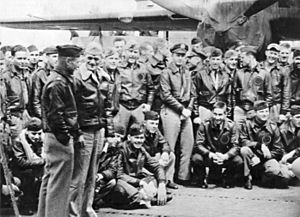
When World War II began, Captain Mitscher was in command of the new aircraft carrier USS Hornet. The Hornet was in Virginia when the Japanese attacked Pearl Harbor. Mitscher worked hard to get his ship and crew ready for battle.
He was asked if long-range bombers could take off from a carrier. Mitscher said yes! So, sixteen B-25 bombers for the famous Doolittle Raid were loaded onto the Hornet. These planes bombed Tokyo, Japan, which was a big surprise to the Japanese. President Franklin D. Roosevelt famously said the bombers came from "Shangri-la," which was a secret way of referring to the Hornet.
Battle of Midway
In June 1942, Mitscher and the Hornet fought in the Battle of Midway, a very important battle in the Pacific. The Hornet and another carrier, Enterprise, carried the main strike force.
During the battle, the Hornet's torpedo bombers, led by Lieutenant Commander John C. Waldron, flew directly to the enemy carriers. They had no fighter planes to protect them. All fifteen of their planes were shot down by Japanese fighters. Only one pilot survived. Even though they didn't hit any Japanese ships, their brave attack distracted the enemy. This allowed other American dive bombers to attack the Japanese carriers without much resistance.
Dive bombers from the Enterprise and Yorktown then attacked. They hit three Japanese carriers, setting them on fire and sinking them. This was a huge victory for the U.S. Navy. Mitscher was proud of his crew, but he felt great sadness for the loss of Waldron and his squadron. He tried for years to get them the Medal of Honor. They eventually received the Navy Cross.
Commander in the Solomon Islands
After Midway, Mitscher was promoted to Rear Admiral. In 1943, he was sent to Guadalcanal in the South Pacific. He became Commander Air, Solomon Islands (COMAIRSOLS). Here, he led a mix of Army, Navy, Marine, and New Zealand aircraft. They fought constant air battles over Guadalcanal and the nearby islands.
Mitscher brought a new, aggressive spirit to the air commands. He said this job, managing the constant air combat, was his toughest duty of the war.
Leading the Fast Carrier Task Force

Mitscher returned to the Central Pacific as Commander, Carrier Division 3. He was put in charge of developing and operating a new group of ships called the Fast Carrier Task Force. This force, known as Task Force 58, was part of Admiral Raymond A. Spruance's Fifth Fleet.
Before this, aircraft carriers were mostly used for quick raids. But Mitscher changed that. He showed that naval air power could fight land-based air power for a long time. This was a huge change in how naval battles were fought.
In early 1944, Mitscher's task force attacked Japanese air defenses in the Marshall Islands. They destroyed many Japanese planes and airfields. This helped save many lives when U.S. Marines later invaded the islands. This success set a pattern for future Pacific operations.
Next, Mitscher led a raid against Chuuk Lagoon, a major Japanese naval base. His forces surprised the enemy with a dawn attack. They destroyed many aircraft and sunk several ships. Mitscher's attacks showed that the Fast Carrier Task Force could overwhelm the air defenses of many island groups at once.
In June 1944, Mitscher's aviators crushed Japanese carrier forces in the Battle of the Philippine Sea. This battle was also called the "Great Marianas Turkey Shoot" because so many Japanese planes were shot down.
One memorable moment happened when American planes had to return to their carriers in the dark. Mitscher ordered all the carriers to turn on their flight deck lights. This was risky because it could attract enemy submarines. But he did it to give his pilots the best chance to land safely.
Facing Kamikaze Attacks
In 1944 and 1945, Vice Admiral Mitscher's fast carriers led the attacks against Japan. They supported the invasions of the Philippines, Iwo Jima, and Okinawa. During the Battle of Okinawa, Mitscher had to keep his fleet at sea for two months. They were constantly attacked by Japanese kamikaze planes, which were planes flown by pilots who crashed them into ships on purpose. This was a very stressful time.
On May 11, 1945, Mitscher's flagship, Bunker Hill, was hit by kamikazes. Many of his staff were killed or wounded. Mitscher had to move his command to another carrier, the Enterprise. When the Enterprise was also hit, he moved again to USS Randolph.
Mitscher repeatedly led his carriers north to attack air bases on the Japanese home islands. Admiral Nimitz, a top Navy commander, praised Mitscher. He said Mitscher was the most experienced and skilled officer in handling fast carrier task forces.
After the War
After World War II, Mitscher became Deputy Chief of Naval Operations for Air. He received many awards, including three Navy Crosses. In 1946, he became Commander-in-Chief of the U.S. Atlantic Fleet, with the rank of Admiral.
Admiral Marc Mitscher passed away on February 3, 1947, at the age of 60. He was buried in Arlington National Cemetery.
Mitscher's Leadership Style
Mitscher was a quiet and reserved man, but he had a strong natural authority. He didn't like officers who weren't good at their jobs, but he was understanding of honest mistakes. He believed that harsh discipline could hurt more than help, especially for pilots who needed to be independent thinkers.
Mitscher understood the powerful and destructive force of aircraft carriers. He came up with the idea of using groups of three or four carriers together. This allowed them to have more fighter planes for better defense.
For attacks, Mitscher trained his air groups to hit the enemy with maximum force while keeping his own pilots safe. He wanted well-coordinated attacks. First, fighter planes would shoot at enemy ships to stop their anti-aircraft fire. Then, bombers and torpedo planes would attack at the same time. This would overwhelm the enemy's defenses. The attack would be over quickly, and the planes would leave.
Caring for His Pilots
Mitscher deeply valued his pilots and respected the risks they took. He always wanted to rescue as many downed airmen as possible. He hated to lose a man, whether lost at sea or captured by the Japanese. He had been stranded himself once, so he understood how important rescue was.
His care for his pilots was shown during the Battle of the Philippine Sea. He ordered the fleet to turn on its flight deck lights at night, even though it was risky. He did this so his pilots, who were low on fuel, could find their way back to the carriers.
Personality and Relations
Mitscher was known for being very quiet. He rarely spoke much, except about fishing, which he loved. He also enjoyed reading mystery novels. Even though he seemed serious, he cared deeply for his men and had a dry sense of humor.
He always followed orders from his superiors, even if he disagreed. This was clear in the Battle of the Philippine Sea and the Battle of Leyte Gulf. However, during the Battle of Okinawa, he took a bold step. He launched a massive air strike against the Japanese battleship Yamato without waiting for his superior's full approval. He wanted to prove that air power alone could defeat a surface fleet. His air strikes successfully sank the Yamato and other ships, proving his point.
Legacy
Two Navy ships have been named USS Mitscher (DL-2) and USS Mitscher (DDG-57) in his honor. An airfield and a street at Marine Corps Air Station Miramar are also named after him.
In 1989, Mitscher was recognized in the International Air & Space Hall of Fame. Admiral Arleigh Burke, who was Mitscher's chief of staff, gave a great tribute to him. He said Mitscher's care for his people helped him become the best carrier force commander in the world.
Awards and Decorations
Ribbon bar of Admiral Mitscher:
 |
|||||
| Badge | Naval Aviator Badge | |||||||||||||
|---|---|---|---|---|---|---|---|---|---|---|---|---|---|---|
| 1st Row | Navy Cross with two gold stars |
|||||||||||||
| 2nd Row | Navy Distinguished Service Medal with two gold stars |
Legion of Merit with "V" Device | Presidential Unit Citation with two stars |
|||||||||||
| 3rd Row | Mexican Campaign Medal | World War I Victory Medal with "Escort" Clasp |
American Defense Service Medal with "A" device |
|||||||||||
| 4th Row | American Campaign Medal | Asiatic-Pacific Campaign Medal with one silver and three bronze service stars |
World War II Victory Medal | |||||||||||
| 5th Row | Philippine Liberation Medal with two stars |
Companion of the Order of the Bath (United Kingdom) |
Commander of the Order of the Tower and Sword (Portugal) |
|||||||||||
Images for kids
See also
 In Spanish: Marc A. Mitscher para niños
In Spanish: Marc A. Mitscher para niños
- List of military figures by nickname


